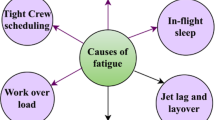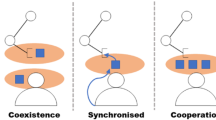Abstract
This paper presents the concept of Cognitive Human-Machine Interfaces and Interactions (CHMI2) for Unmanned Aircraft System (UAS) Ground Control Stations (GCS). CHMI2 represents a new approach to aviation human factors engineering that introduces adaptive functionalities in the design of operators’ command, control and display functions. A CHMI2 system assesses human cognitive states based on measurement of key psycho-physiological observables. The cognitive states are used to predict and enhance operator performance in the accomplishment of aviation tasks, with the objective of improving the efficiency and effectiveness of the overall human-machine teaming. The CHMI2 system presented in this paper employs a four-layer architecture comprising sensing, extraction, classification and adaptation functionalities. An overview of each layer is provided along with the layer’s metrics, algorithms and functions. Two relevant case studies are presented to illustrate the interactions between the different layers, and the conceptual design of the associated display formats is described. The results indicate that specific eye tracking variables provide discrimination between different modes of control. Furthermore, results indicate that the higher levels of automation supported by the CHMI2 are beneficial in Separation Assurance and Collision Avoidance (SA&CA) scenarios involving low-detectability obstacles and stringent time constraints to implement recovery manoeuvres. These preliminary results highlight that the introduction of CHMI2 functionalities in future UAS can significantly reduce reaction time and enhance operational effectiveness of unmanned aircraft response to collision and loss of separation events, as well as improve the overall safety and efficiency of operations.
Similar content being viewed by others
References
Jiang, T., Geller, J., Ni, D., Collura, J.: Unmanned aircraft system traffic management: Concept of operation and system architecture, International Journal of Transportation Science and Technology (2017)
FAA: Integration of Civil Unmanned Aircraft Systems (UAS) in the National Airspace System (NAS) Roadmap, 1st edn. Federal Aviation Administration, Washington (2013)
Dalamagkidis, K., Valavanis, K.P., Piegl, L.A.: Thoughts and Recommendations on a UAS Integration Roadmap. In: On Integrating Unmanned Aircraft Systems into the National Airspace System, ed, pp. 161–191 (2012)
Gardi, A., Ramasamy, S., Kistan, T., Sabatini, R.: UAS in the terminal area: challenges and opportunities. Wiley (2016)
Viguria, A.: Autonomy architectures. In: Encyclopedia of aerospace engineering. Wiley (2016)
Liu, J., Gardi, A., Ramasamy, S., Lim, Y., Sabatini, R.: Cognitive pilot-aircraft interface for single-pilot operations. Knowl.-Based Syst. 112, 37–53 (2016)
ICAO: Doc 10019: Manual on Remotely Piloted Aircraft Systems (RPAS), 1st edn. International Civil Aviation Organization, Montréal (2015)
Neville, K., Blickensderfer, B., Archer, J., Kaste, K., Luxion, S.P.: A Cognitive Work Analysis to Identify Human-Machine Interface Design Challenges Unique to Uninhabited Aircraft Systems. In: Proceedings of the Human Factors and Ergonomics Society Annual Meeting, pp. 418–422 (2012)
Ramasamy, S., Sabatini, R., Gardi, A.: Cooperative and non-cooperative sense-and-avoid in the CNS + A context: A unified methodology. In: 2016 International Conference on Unmanned Aircraft Systems (ICUAS), pp. 531–539 (2016)
Ramasamy, S., Sabatini, R., Gardi, A., Liu, J.: LIDAR obstacle warning and avoidance system for unmanned aerial vehicle sense-and-avoid, Aerospace Science and Technology (2016)
Lai, J., Ford, J.J., Mejias, L., Wainwright, A.L., O’Shea, P.J., Walker, R.A.: Field-of-view, detection range, and false alarm trade-offs in vision-based aircraft detection (2012)
Lai, J., Mejias, L., Ford, J.J.: Airborne vision-based collision-detection system. J. Field Robot. 28, 137–157 (2011)
Gevins, A., Leong, H., Du, R., Smith, M.E., Le, J., DuRousseau, D., et al.: Towards measurement of brain function in operational environments. Biol. Psychol. 40, 169–186 (1995)
Glaholt, M.G.: Eye tracking in the cockpit: a review of the relationships between eye movements and the aviator’s cognitive state (2014)
Rubio, S., Díaz, E, Martín, J., Puente, J.M.: Evaluation of subjective mental workload: A comparison of SWAT, NASA-TLX, and workload profile methods. Appl. Psychol. 53, 61–86 (2004)
Kramer, A.F.: Physiological Metrics of Mental Workload: A Review of Recent Progress. In: Multiple-Task Performance, Damos, D. London: Taylor & Francis, pp. 279–328 (1991)
Gevins, A., Smith, M.E.: Neurophysiological measures of cognitive workload during human-computer interaction. Theor. Issues Ergon. Sci. 4, 113–131 (2003)
Roscoe, A.H.: Assessing pilot workload. Why measure heart rate, HRV and respiration? Biol. Psychol. 34, 259–287 (1992)
Henelius, A., Hirvonen, K., Holm, A., Korpela, J., Muller, K.: Mental workload classification using heart rate metrics. In: 2009 Annual International Conference of the IEEE Engineering in Medicine and Biology Society, pp. 1836–1839 (2009)
Marshall, S.P.: The index of cognitive activity: Measuring cognitive workload. In: 2002. Proceedings of the 2002 IEEE 7th Conference on Human Factors and Power Plants, pp. 7–5-7-9 (2002)
Harris, Sr., R.L., Glover, B.J., Spady, Jr., A.A.: Analytical techniques of pilot scanning behavior and their application (1986)
Jacob, R., Karn, K.S.: Eye tracking in human-computer interaction and usability research: Ready to deliver the promises. Mind 2, 4 (2003)
Di Nocera, F., Camilli, M., Terenzi, M.: A random glance at the flight deck: Pilots’ scanning strategies and the real-time assessment of mental workload. J. Cogn. Eng. Decis. Making 1, 271–285 (2007)
Salvucci, D.D., Goldberg, J.H.: Identifying fixations and saccades in eye-tracking protocols. In: Proceedings of the 2000 Symposium on Eye Tracking Research & Applications, pp. 71–78 (2000)
Gilland, J.: Driving, eye-tracking and visual entropy: Exploration of age and task effects: ProQuest (2008)
Kohlmorgen, J., Dornhege, G., Braun, M., Blankertz, B., Mller, K.-.R., Curio, G., et al.: Improving Human Performance in a Real Operating Environment Through Real-time Mental Workload Detection. In: Toward Brain-Computer Interfacing, Dornhege, G., Milln, J., Hinterberger, T., McFarland D. and Mller, K.-.R. Cambridge: MIT Press, pp. 409–422 (2007)
Stevens, R., Galloway, T., Berka, C.: Integrating EEG models of cognitive load with machine learning models of scientific problem solving. Augmented Cogn. Past Present Fut. 2, 55–65 (2006)
Ke, Y., Qi, H., Zhang, L., Chen, S., Jiao, X., Zhou, P., et al.: Towards an effective cross-task mental workload recognition model using electroencephalography based on feature selection and support vector machine regression. Int. J. Psychophysiol. 98, 157–166 (2015)
Yin, Z., Zhang, J., Wang, R.: Neurophysiological Feature-Based Detection of Mental Workload by Ensemble Support Vector Machines. In: Advances in Cognitive Neurodynamics (V), ed, pp. 469–475. Springer (2016)
Wilson, G.F., Russell, C.A.: Real-time assessment of mental workload using psychophysiological measures and artificial neural networks. Human Factors J. Human Factors Ergon. Soc. 45, 635–644 (2003)
Noel, J.B., Bauer, K.W., Lanning, J.W.: Improving pilot mental workload classification through feature exploitation and combination: a feasibility study. Comput. Oper. Res. 32, 2713–2730 (2005)
Yang, G., Lin, Y.: Using ECG signal to quantify mental workload based on wavelet transform and competitive neural network techniques (special issuebiosensors: data acquisition, processing and control). Biomed. Fuzzy Human Sci. Off. J. Biomed. Fuzzy Syst. Assoc. 14, 17–25 (2009)
Zarjam, P., Epps, J., Chen, F., Lovell, N.H.: Estimating cognitive workload using wavelet entropy-based features during an arithmetic task. Comput. Biol. Med. 43, 2186–2195 (2013)
Honal, M., Schultz, T.: Determine task demand from brain activity. In: Biosignals (1), pp. 100–107 (2008)
Wang, Z., Hope, R.M., Wang, Z., Ji, Q., Gray, W.D.: Cross-subject workload classification with a hierarchical Bayes model. NeuroImage 59, 64–69 (2012)
Besson, P., Bourdin, C., Bringoux, L., Dousset, E., Maïano, C., Marqueste, T., et al.: Effectiveness of physiological and psychological features to estimate helicopter pilots’ workload: A Bayesian network approach. IEEE Trans. Intell. Transp. Syst. 14, 1872–1881 (2013)
Guhe, M., Gray, W.D., Schoelles, M.J., Liao, W., Zhu, Z., Ji, Q.: Non-intrusive measurement of workload in real-time. In: Proceedings of the Human Factors and Ergonomics Society Annual Meeting, pp. 1157–1161 (2005)
Chaouachi, M., Jraidi, I., Frasson, C.: Modeling mental workload using EEG features for intelligent systems. In: International Conference on User Modeling, Adaptation, and Personalization, pp. 50–61 (2011)
Sabatini, R., Moore, T., Hill, C.: A novel GNSS integrity augmentation system for civil and military aircraft. Int. J. Mech. Indust. Sci. Eng. 7, 1433–1449 (2013)
Mulder, M., Van Der Vaart, H.J.C.: An information-centered analysis of the tunnel-in-the-sky display, part: The interception of curved trajectories. Int. J. Aviat. Psychol. 16, 21–49 (2006)
Author information
Authors and Affiliations
Corresponding author
Rights and permissions
About this article
Cite this article
Lim, Y., Ramasamy, S., Gardi, A. et al. Cognitive Human-Machine Interfaces and Interactions for Unmanned Aircraft. J Intell Robot Syst 91, 755–774 (2018). https://doi.org/10.1007/s10846-017-0648-9
Received:
Accepted:
Published:
Issue Date:
DOI: https://doi.org/10.1007/s10846-017-0648-9




